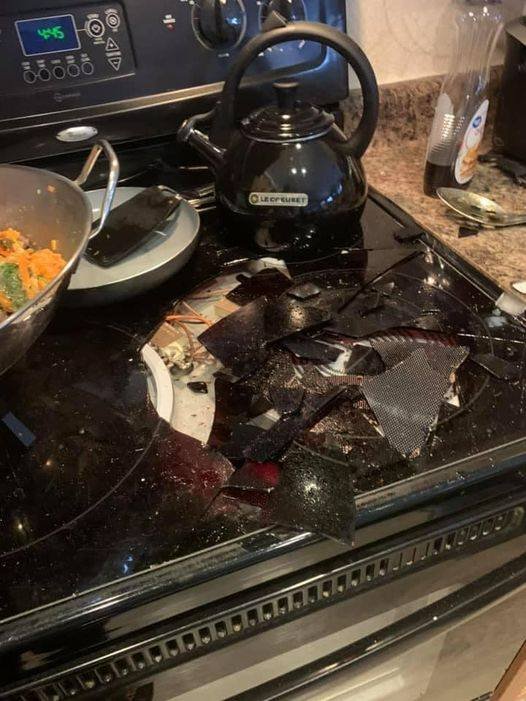Glass stovetops are a sleek and modern addition to many kitchens, offering a smooth surface that’s easy to clean and visually appealing. However, they require careful handling to maintain their appearance and functionality. Improper use can lead to scratches, cracks, and even safety hazards. To keep your glass stovetop in excellent condition, here are ten common mistakes to avoid.

1. Using Rough or Abrasive Cleaners
One of the fastest ways to damage your glass stovetop is by using harsh or abrasive cleaning tools. Steel wool, scrubbing pads, or abrasive chemical cleaners can leave scratches on the surface, dulling its shine and weakening its structure over time. Instead, use a gentle cleaning solution specifically designed for glass stovetops. Soft materials like microfiber cloths or non-abrasive sponges work best for cleaning without causing damage.
2. Placing Heavy Pots and Pans
While glass stovetops are designed to handle the demands of cooking, they are not built to support extremely heavy cookware. Placing heavy cast iron pots, oversized pans, or other weighty items can cause the glass to crack or shatter. To avoid accidents, opt for lightweight cookware whenever possible and handle heavy items with extra care.
3. Sliding Pots and Pans
Dragging pots and pans across the surface of a glass stovetop is another common mistake. This can leave scratches that accumulate over time, making the surface look worn and less efficient. Instead of sliding cookware, always lift it when moving from one burner to another. This simple habit can go a long way in preserving your stovetop’s smooth finish.
4. Leaving Spills and Stains
Spills and stains are inevitable when cooking, but leaving them on your glass stovetop can lead to long-term damage. Over time, spills can become baked onto the surface, making them harder to clean and potentially damaging the glass. Always clean spills promptly using a damp cloth or a stovetop-safe cleaner. Addressing messes as they happen will keep your stovetop looking pristine and prevent stubborn stains.
5. Cooking with Dirty Cookware
Using pots and pans with dirty or greasy bottoms can harm your glass stovetop. Residue from the cookware can transfer to the glass, causing stains or scratches. Before placing cookware on the stovetop, check that the bottoms are clean and free of debris. This simple step not only protects your stovetop but also ensures more efficient cooking.
6. Placing Hot Lids Face Down
Hot lids, particularly glass ones, can cause sudden temperature changes when placed face down on a cool stovetop. This can result in thermal shock, leading to cracks or shattering. To avoid this, always place hot lids on a heat-resistant surface like a trivet or a pot holder.
7. Ignoring Cracks or Chips
Small cracks or chips on a glass stovetop may not seem like a big deal at first, but they can quickly worsen. Heat and pressure can expand the damage, potentially causing the entire stovetop to shatter during use. If you notice any damage, it’s important to address it immediately. Contact a professional repair service to assess and fix the issue before it becomes a safety hazard.
8. Heating an Empty Pot or Pan
Placing an empty pot or pan on a hot burner is another habit that can harm your glass stovetop. Empty cookware can overheat, causing the surface to become discolored, warped, or even cracked. To avoid this, always make sure there is food or liquid in your pots and pans before turning on the heat.
9. Using the Wrong Cookware
Not all cookware is suitable for glass stovetops. Cookware with warped or uneven bottoms can cause uneven heating and create hot spots, which can damage the surface. Similarly, heavy materials like cast iron or stoneware are more likely to scratch or crack the glass. Stick to cookware with flat, smooth bottoms, such as stainless steel or anodized aluminum, for the best results.
10. Ignoring Manufacturer’s Instructions
Every glass stovetop comes with specific care instructions provided by the manufacturer. Ignoring these guidelines can lead to unnecessary damage or void your warranty. Always read the user manual and follow the recommended practices for cleaning, maintenance, and selecting appropriate cookware. These instructions are designed to help you get the most out of your stovetop while avoiding common pitfalls.
Conclusion: Protect Your Glass Stovetop
Glass stovetops add a touch of elegance to any kitchen, but they require proper care to remain in good condition. By avoiding these ten dangerous habits, you can prevent scratches, cracks, and other damage that could compromise your stovetop’s appearance and performance.
Regular cleaning, careful handling of cookware, and adherence to the manufacturer’s guidelines are key to maintaining your stovetop’s sleek look and functionality. With these simple precautions, your glass stovetop will continue to be a beautiful and efficient centerpiece in your kitchen for years to come.





